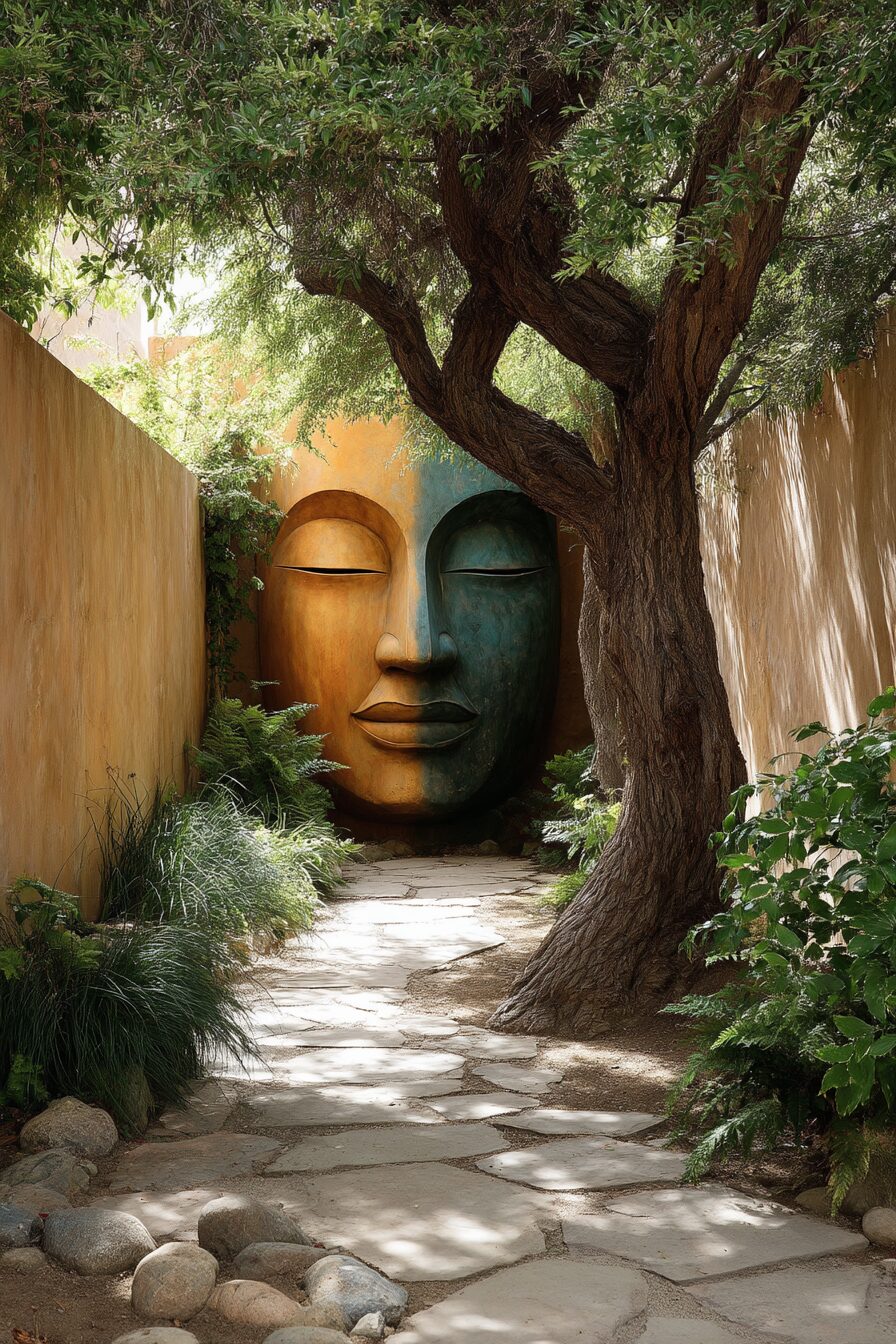Your front yard is your home’s first impression and handshake with the world.
If you’ve got a tiny patch of grass or sprawling acreage, these eye-catching landscaping ideas will transform your curb appeal from forgettable to photo-worthy.
Create a Grand Entrance with a Defined Pathway
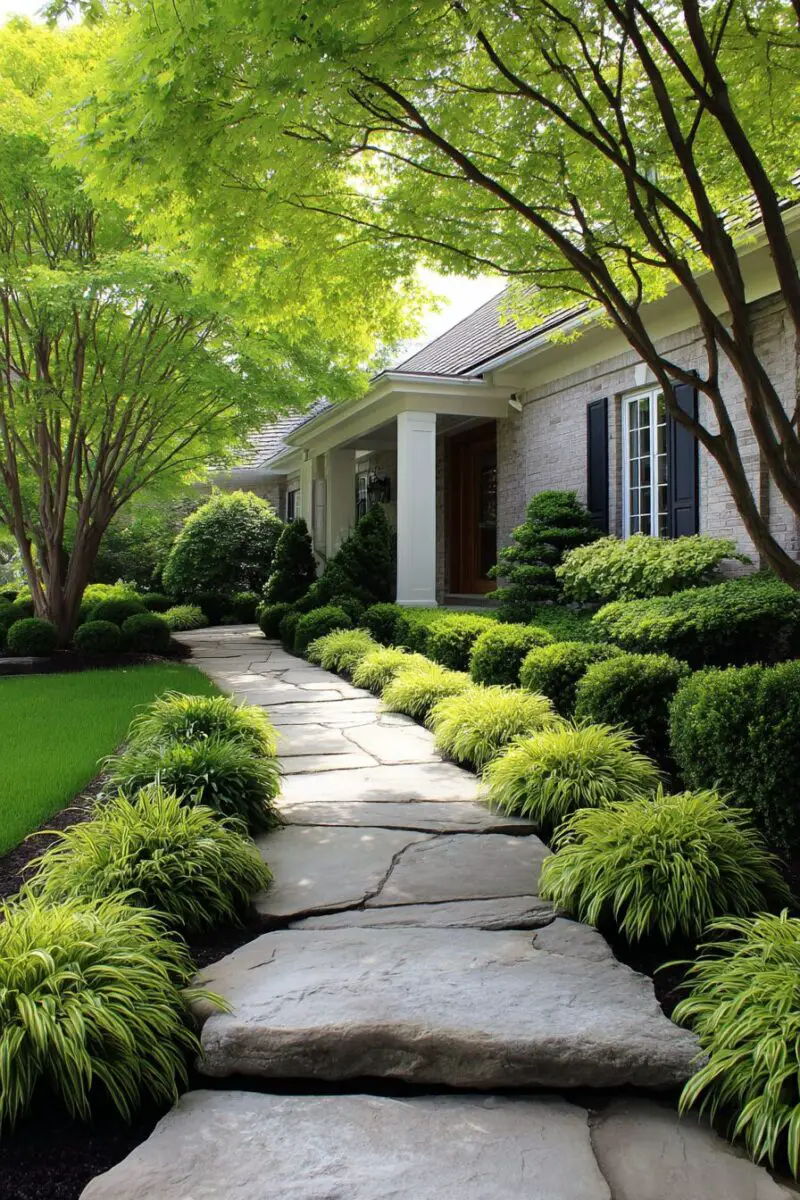
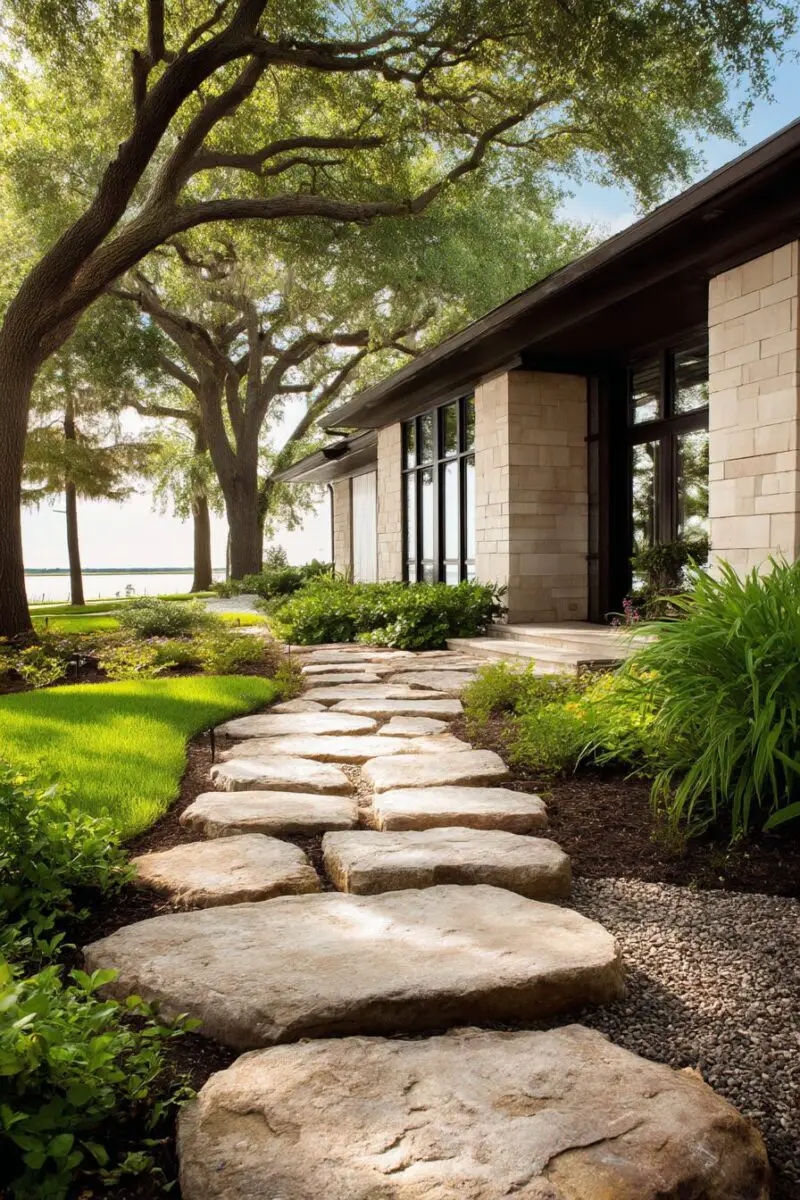
Nothing says “welcome to my stunning home” like a thoughtfully designed pathway.
A curved walkway creates visual interest and invites visitors to discover what lies ahead, much more effectively than a straight line from sidewalk to door.
Materials matter tremendously when designing your perfect path.
Border your pathway with low-growing plants like lavender or boxwood to soften edges and guide the eye forward.
Solar-powered pathway lights installed along the edges serve double duty by illuminating the way for safety while creating a magical nighttime atmosphere.
Widen your pathway at strategic points to create small gathering areas or visual pauses that enhance the journey to your front door.
Add unexpected touches like mosaic inserts, patterned brickwork, or even scented plants that release their fragrance when brushed against.
Remember that your pathway should complement your home’s architectural style—formal symmetrical paths work beautifully with colonial homes, while meandering stone paths complement cottages and ranch styles.
For maximum impact, create a slight elevation change with two or three wide, shallow steps that make your front door appear more prominent and stately.
Design a Multi-Season Garden That Always Looks Amazing
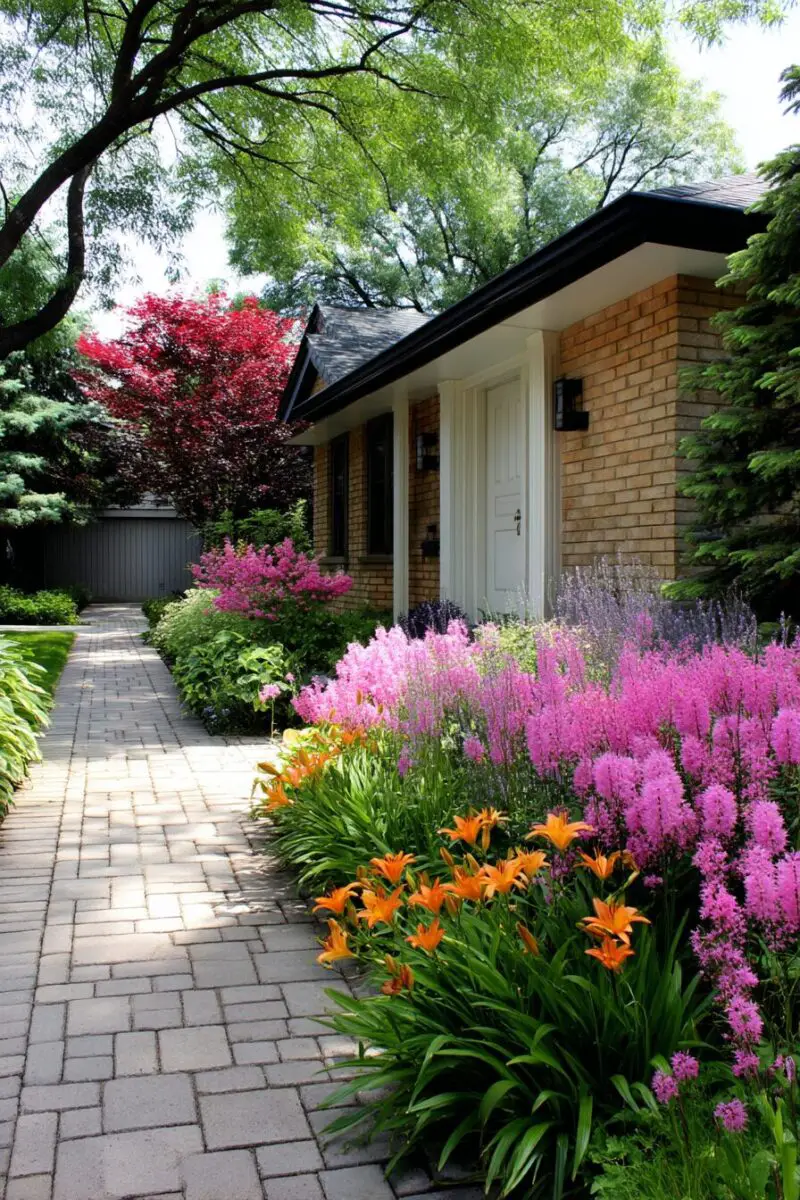
The secret to a front yard that stops traffic year-round is thoughtful planning across all four seasons.
Spring can showcase daffodils, tulips, and flowering trees like dogwoods or cherry blossoms that create spectacular seasonal displays.
Summer might feature hydrangeas, roses, and perennial favorites that provide reliable color throughout the hottest months.
Fall brings opportunities for spectacular color with maple trees, ornamental grasses reaching their full glory, and late-blooming perennials.
Winter interest, often overlooked, comes from evergreens, interesting bark patterns, berries, and architectural elements that shine when snow falls.
Incorporate plants with various textures and leaf shapes to create visual interest even when nothing is blooming.
Choose at least one spectacular specimen plant that serves as a focal point—perhaps a Japanese maple, a weeping cherry, or a uniquely shaped evergreen.
Plant in odd-numbered groupings (3, 5, 7) rather than pairs for a more natural, designer-approved aesthetic.
Remember that rhythm and repetition of key plants throughout your front yard creates cohesion and guides the eye from one beautiful area to the next.
Design Your Dream Room in Minutes!
🏡 Start Creating FREE →Incorporate Stunning Hardscaping Elements
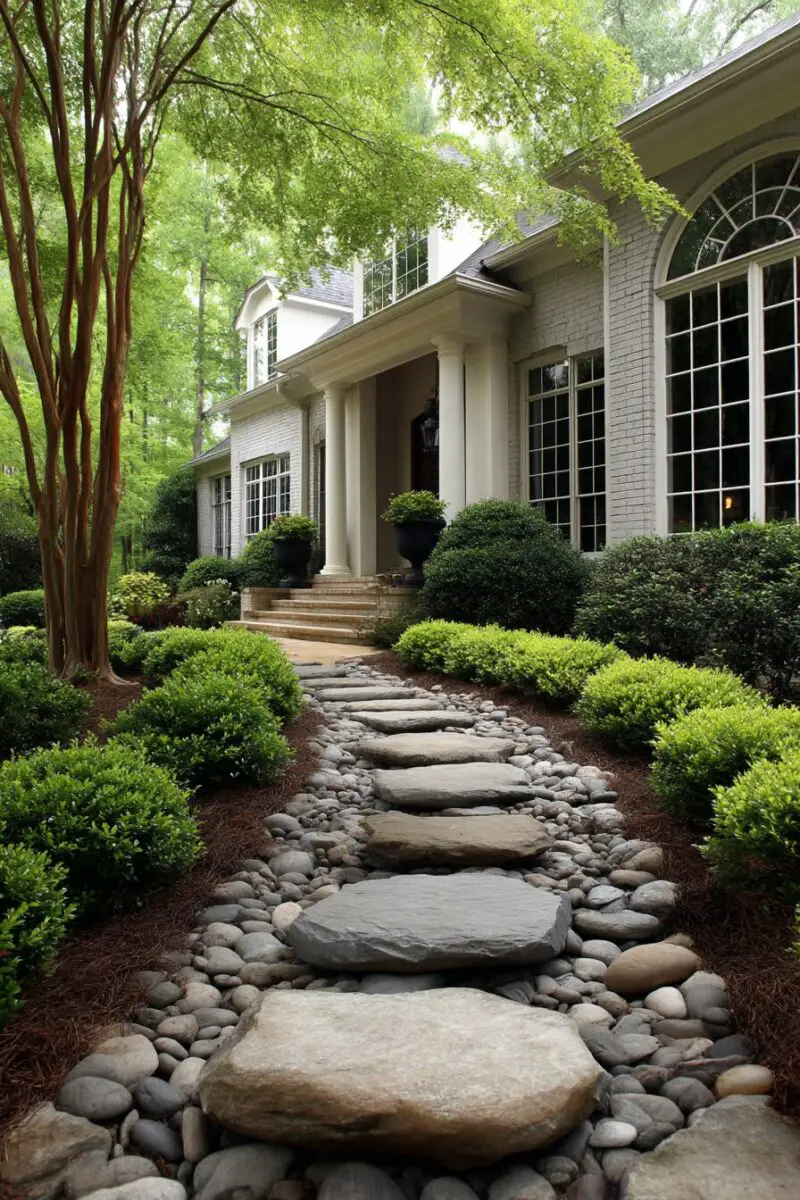
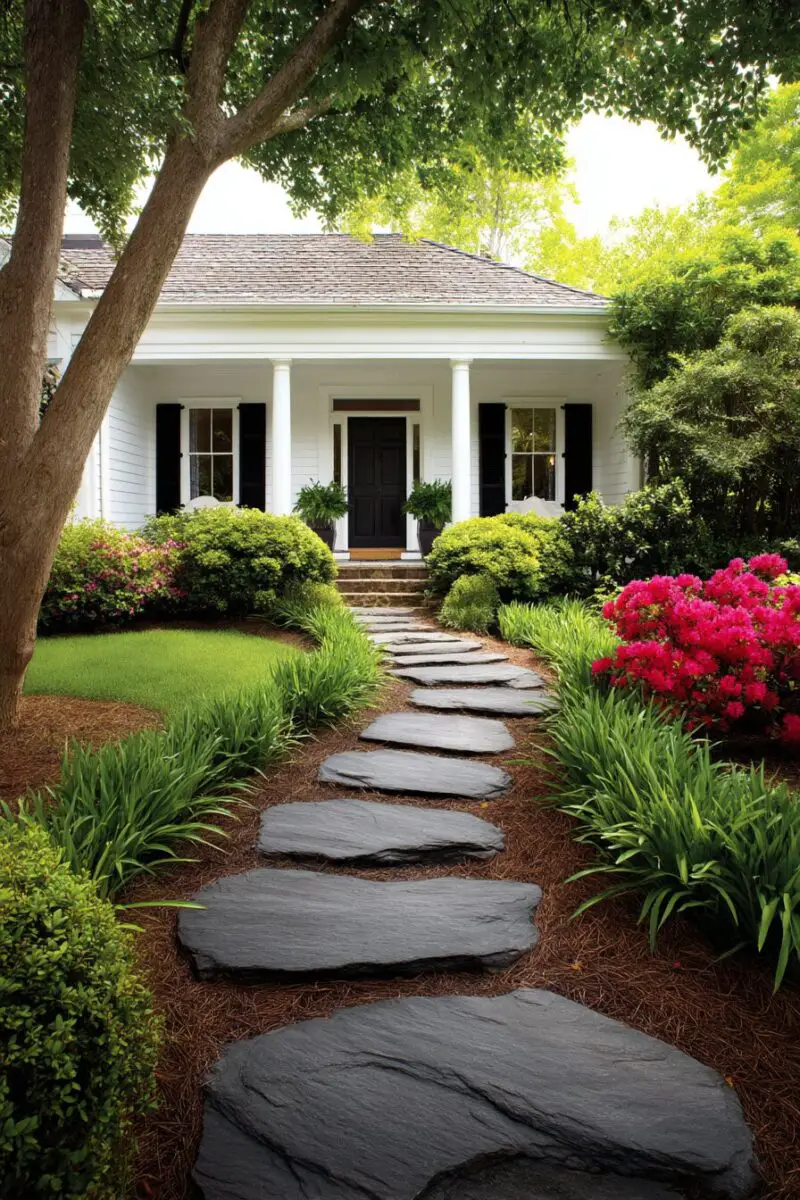
Hardscaping provides the bones of your landscape and creates impact even when plants are dormant.
A dry stack stone wall instantly adds character, creates terracing opportunities on sloped yards, and provides seating in strategic locations.
Decorative boulders strategically placed throughout planting beds add natural sculptural elements and create microenvironments for special plants.
A pergola-covered entryway transforms your approach with architectural impact while providing support for climbing plants like wisteria or clematis.
Custom fence panels with unique cutouts or artistic elements turn a functional barrier into a conversation piece.
Modern metal planters arranged asymmetrically can create a contemporary vibe that complements sleek architectural homes.
Incorporate seating elements that invite lingering, like a built-in stone bench nestled into a retaining wall or a charming garden bench under a tree.
Retaining walls faced with natural stone or contemporary materials can transform a problematic slope into a dramatic multi-level garden.
Decorative gravel or crushed stone pathways in unexpected colors create textural interest and solve drainage issues while eliminating lawn maintenance.
TRENDING NOW
13 Boho Patio Ideas For Enchanting Outdoor SpacesCreate a Stunning Native Plant Sanctuary
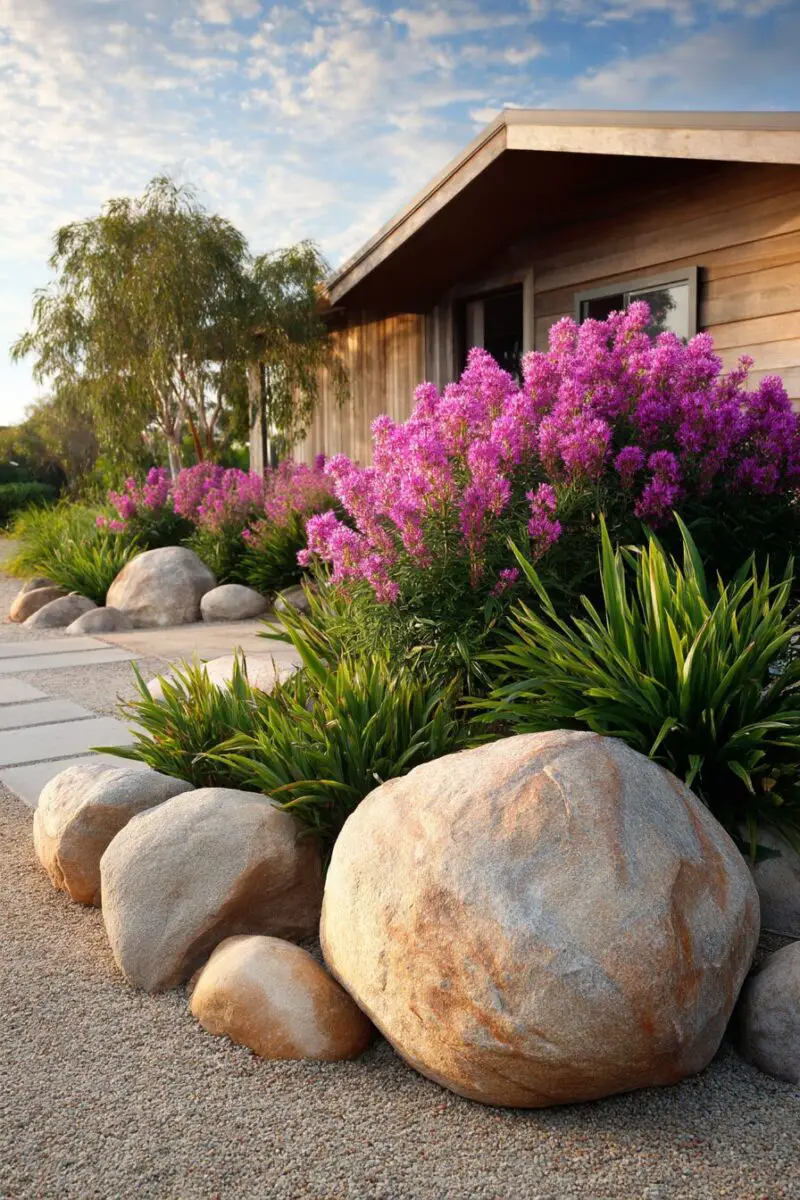
Native plants create a front yard that not only looks spectacular but also supports local wildlife and requires minimal maintenance.
Choosing plants indigenous to your region means they’ve evolved to thrive in your specific climate, soil conditions, and rainfall patterns.
Prairie-style plantings with native grasses like switchgrass or little bluestem create movement and year-round interest with their changing colors.
Native flowering perennials like coneflowers, black-eyed Susans, and bee balm provide months of color while attracting pollinators to your garden.
Indigenous shrubs like viburnum, elderberry, or serviceberry offer multi-season interest with spring flowers, summer berries, and fall color.
Native trees appropriate to your yard size—perhaps redbud, dogwood, or a compact oak variety—provide the perfect anchor for your ecological landscape.
Bird-friendly native plants produce seeds, berries, and attract insects that transform your front yard into a living nature sanctuary.
Group plants according to their water needs, creating rain garden depressions for moisture-loving natives and raised areas for those preferring drier conditions.
Reduce or eliminate traditional lawn areas by replacing them with native groundcovers like sedges, wild ginger, or creeping phlox.
Remember that a native plant garden can be just as organized and intentional as conventional landscaping—neat edges, defined paths, and thoughtful groupings create an ecological space that still communicates careful stewardship.
Play with Dramatic Lighting Effects
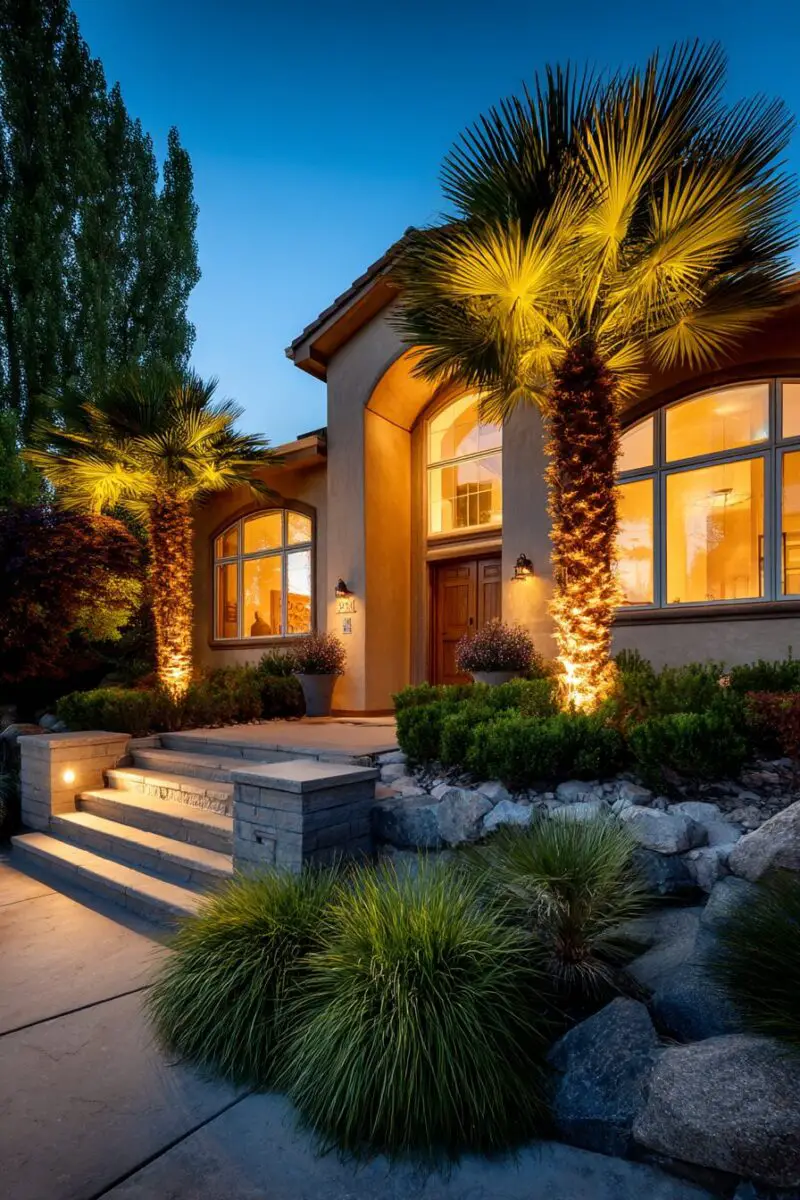
Strategic landscape lighting transforms your front yard from ordinary to extraordinary, especially after sunset.
Uplighting placed at the base of architectural trees creates dramatic shadows and highlights interesting branch structures against your home.
Path lighting that casts gentle pools of light along walkways ensures safety while creating a magical nighttime atmosphere.
Moonlighting techniques, where lights are placed high in trees pointing downward, mimic natural moonlight filtering through branches.
Wall washing involves positioning lights to bathe the front of your home in an even glow, highlighting architectural features and creating depth.
Silhouette lighting placed behind interesting plant shapes creates dramatic black outlines against illuminated surfaces.
Spotlighting draws attention to special garden features like specimen plants, water features, or garden art that deserve extra attention.
Remember that less is often more with landscape lighting—strategic illumination of key elements creates more drama than lighting everything.
Automated systems with timers and smart controls ensure your lighting activates at sunset and adjusts seasonally without requiring your attention.
TRENDING NOW
13 Outdoor Gazebo Ideas To Transform Your BackyardDesign an Eco-Friendly Rain Garden
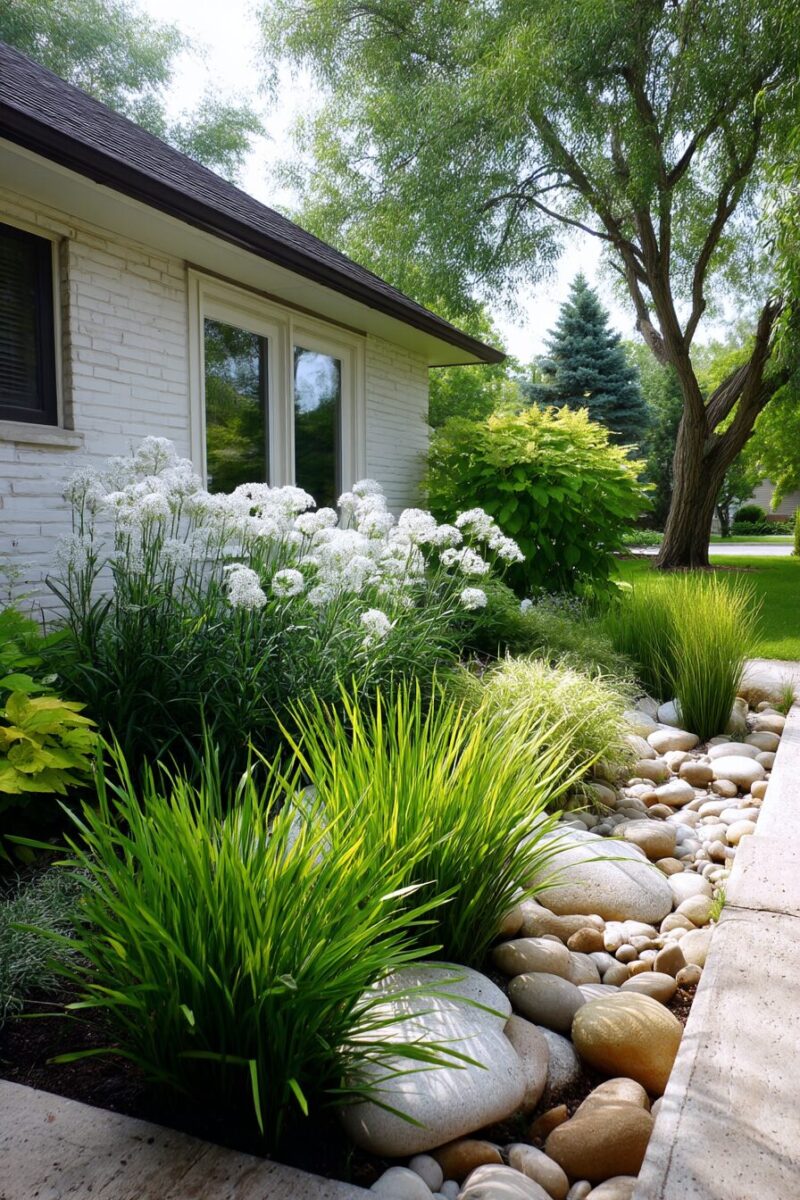
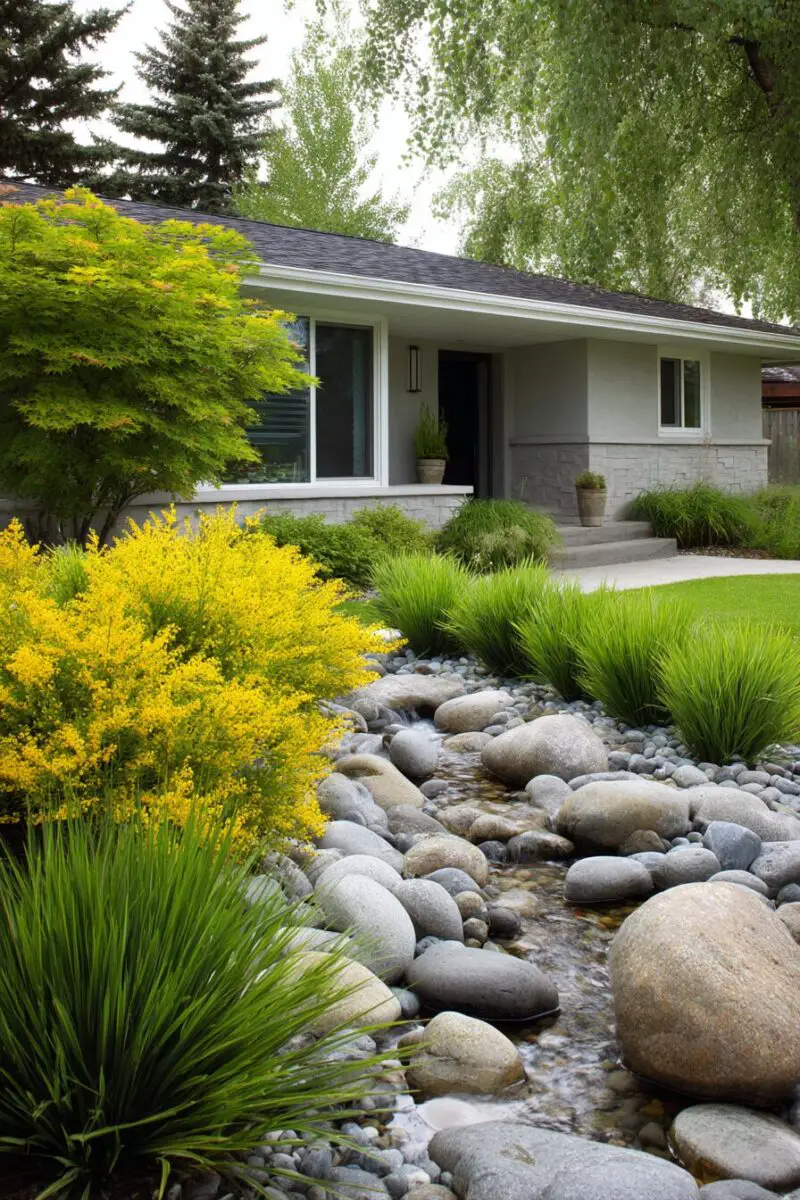
Rain gardens solve drainage problems while creating stunning, environmentally responsible landscape features.
These specially designed depressions collect rainwater runoff from your roof, driveway, and lawn, preventing erosion and filtering pollutants naturally.
The bowl-shaped garden can be designed with decorative rocks, river stones, and water-loving plants that create visual interest even when dry.
Choose native plants with deep root systems like switchgrass, cardinal flower, or blue flag iris that tolerate both wet and dry conditions.
Strategic placement of larger stones creates mini-waterfalls during rain events, turning stormwater into a dramatic sensory experience.
Incorporate a dry creek bed design that channels water through your landscape in an aesthetically pleasing way during heavy downpours.
Layer plants by height, with taller species in the center or back and shorter plants around the edges for a naturally organized appearance.
Add bird baths or shallow water features that refill during rain events, attracting wildlife and adding additional visual interest.
Remember that a well-designed rain garden not only manages water effectively but can become the stunning centerpiece of your front yard landscape.
Create Vertical Interest with Trees and Structures
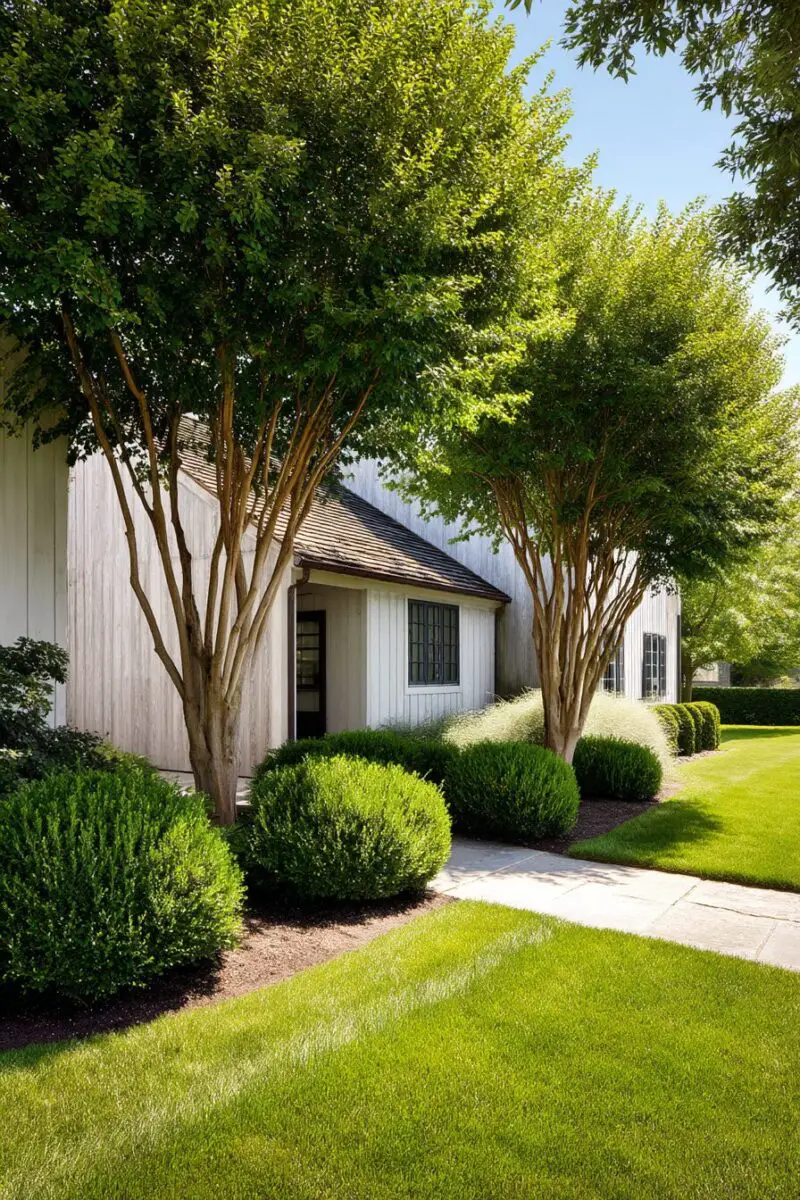
Vertical elements draw the eye upward and create architectural impact that transforms how people perceive your home’s presence.
A properly placed specimen tree—perhaps an ornamental Japanese maple, flowering dogwood, or uniquely shaped evergreen—creates a focal point that anchors your entire landscape.
Espalier fruit trees trained against walls or fences combine ornamental beauty with productive harvesting in minimal space.
Ornamental grasses reaching 5-7 feet tall by late summer create dramatic movement and sound as breezes pass through their airy seed heads.
Column-shaped evergreens like arborvitae or Italian cypress create living architecture that provides year-round structure and privacy.
Living walls or vertical garden systems allow you to grow plants upward, creating lush tapestries of foliage and flowers in small spaces.
Architectural elements like garden obelisks, tuteurs, or decorative posts add height and visual interest while supporting climbing plants.
Remember that vertical elements create the perception of expanded space, making even modest-sized front yards feel more substantial and designed.
Strategic placement of tall elements should consider sight lines, mature plant size, and relationship to your home’s architecture for harmonious integration.
TRENDING NOW
13 Eye-Catching Front Yard Rock Landscaping IdeasIncorporate Eye-Catching Garden Art

Garden art transforms ordinary landscapes into personal expressions that capture attention and create memorable impressions.
A stunning metal sculpture positioned as a focal point creates year-round interest regardless of seasonal plant changes.
Mosaic elements incorporated into pathways, walls, or garden ornaments add unexpected color and personality to your front landscape.
Repurposed vintage items like old gates, wheels, or architectural salvage create character and conversation-starting focal points.
Invest in a showstopping water feature—perhaps a contemporary spill fountain, a classically inspired birdbath, or an artistic bubbling boulder.
Kinetic sculptures that move with the wind create dynamic interest that changes constantly with weather conditions.
Custom address markers or welcome signs designed by artists turn functional elements into unique artistic expressions.
Remember that properly positioned garden art should enhance rather than compete with your landscape, creating focal points that guide visitors through your garden experience.
Incorporate Strategic Berms and Contours

Deliberately created elevation changes transform flat, boring yards into dynamic landscapes with visual depth and interest.
Berms—gently raised mounds of soil—create opportunities for layered plantings that can be viewed from multiple angles.
These raised areas naturally draw the eye and can highlight special specimen plants or garden art placed at their summit.
Strategically placed berms near the road provide privacy by elevating plantings to screen windows without creating a walled-off appearance.
Remember that natural-looking berms have gradual, undulating edges rather than perfectly circular or oval shapes.
Create planting pockets within your contoured landscape where different plant communities can thrive based on sun exposure and drainage.
Use varying mulch materials in different areas to enhance the sense of separate garden rooms within your front landscape.
Incorporate seating or viewing areas that take advantage of the perspectives created by your deliberately shaped terrain.
TRENDING NOW
12+ Cheap & Easy DIY Backyard Makeover IdeasDesign for Privacy Without Walls
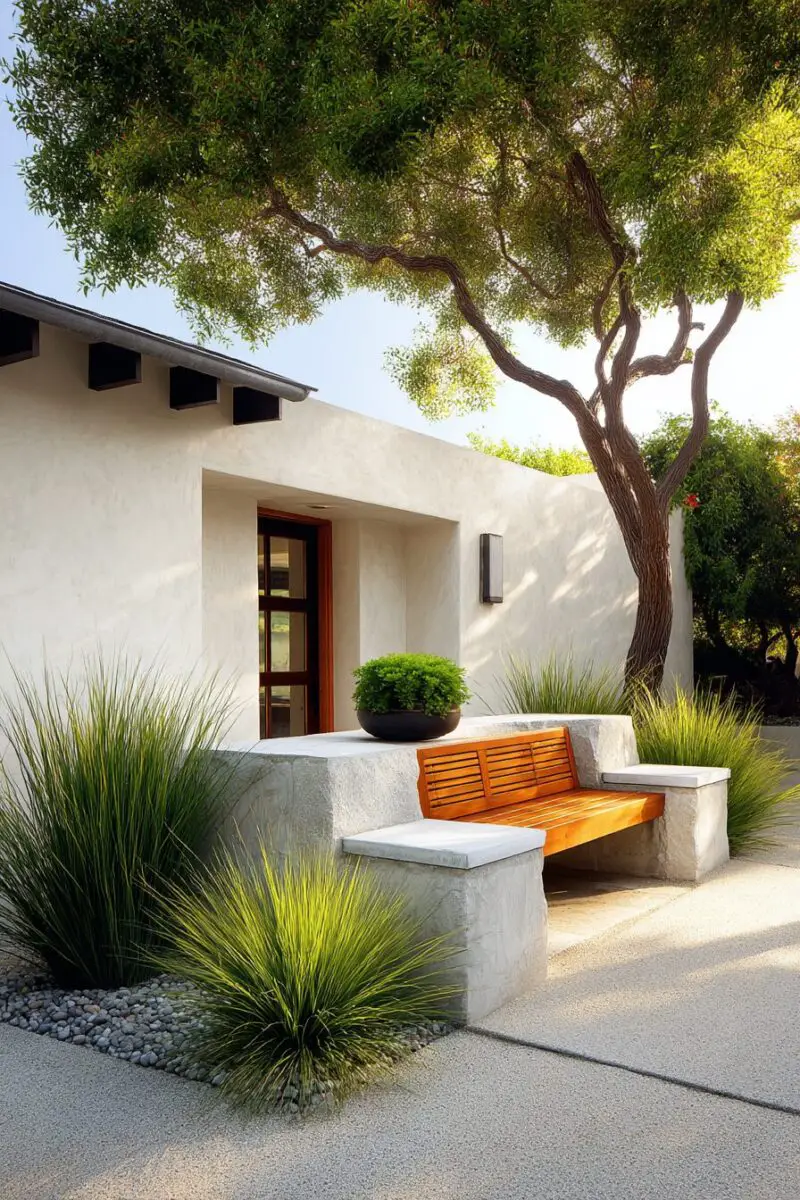
Creating privacy in your front yard doesn’t require fortress-like barriers that disconnect you from your neighborhood.
Strategically placed small trees or large shrubs create living privacy screens that filter views while maintaining an inviting atmosphere.
Tiered plantings with increasing heights moving toward your home create layers of privacy without a single massive hedge.
Decorative panels or lattice sections placed strategically between plantings create architectural interest while blocking direct sight lines.
A thoughtfully positioned water feature masks street noise with soothing sounds while drawing attention away from areas you wish to keep private.
Movable elements like large containers on hidden casters allow you to adjust privacy screens seasonally or for specific occasions.
Pergolas covered with deciduous vines provide summer privacy when leafed out while allowing winter light when dormant.
Remember that partial screening often creates more intrigue and beauty than complete blockades, maintaining neighborhood connection while defining private space.
Incorporate screening elements that multitask—perhaps an espalier fruit tree that provides both privacy and harvests, or flowering shrubs that attract beneficial insects.
Remember that the most successful front yards reflect the personalities of the people who live there while respecting the architecture of the home and the character of the neighborhood.
Start with one impactful change and build from there—even small improvements can dramatically transform how people perceive your home’s curb appeal.

